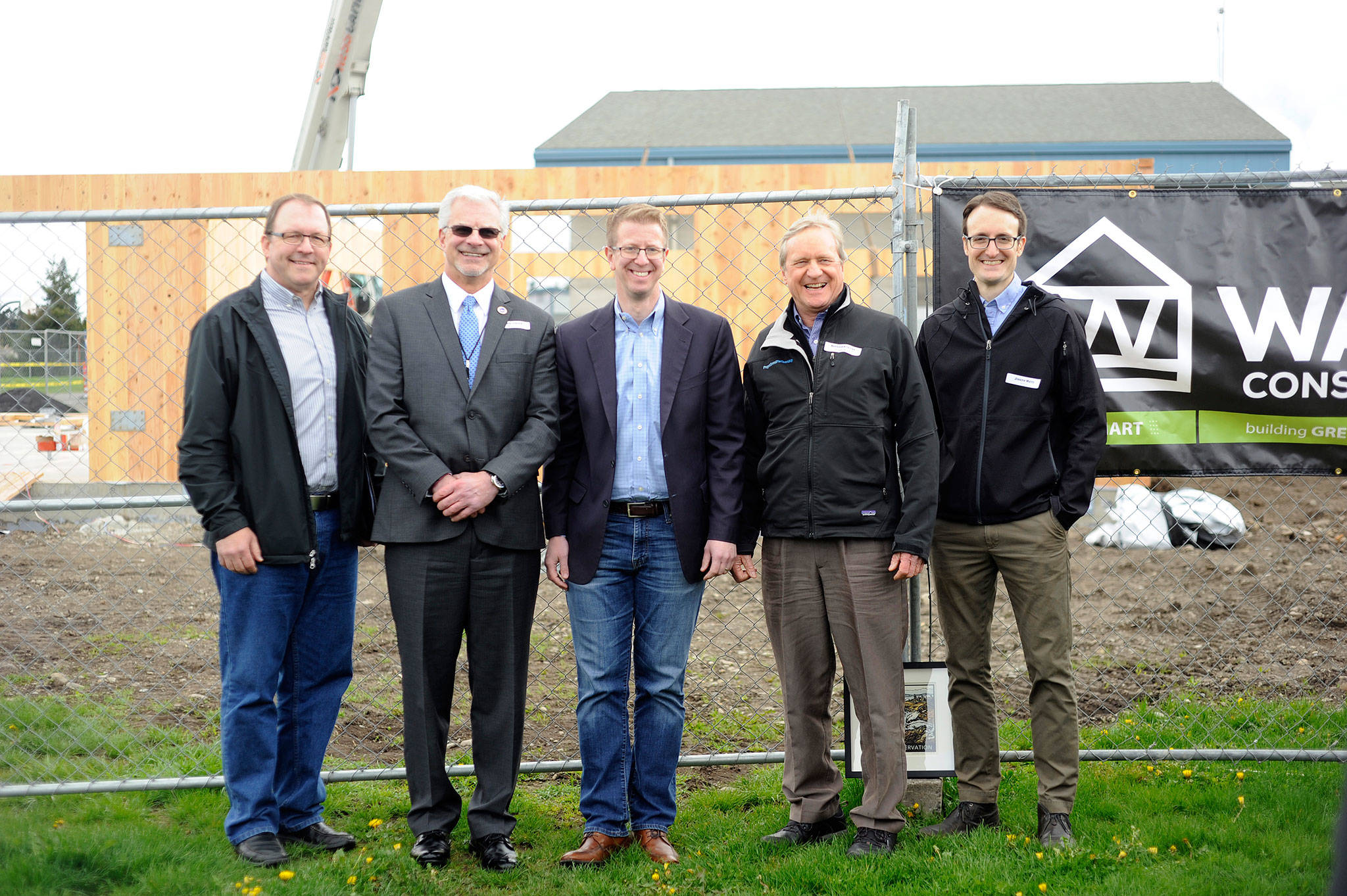State and local leaders hailed the installation of two modular buildings at Greywolf Elementary School this week, structures using cross laminated timber that will house four new classrooms for kindergarten-third grade students at the start of the 2017-2018 school year.
On Monday, April 24, state Rep. Steve Tharinger, U.S. Rep. Derek Kilmer and Sequim School District Superintendent Gary Neal gathered with community members to welcome the official installation of new modular buildings using locally sourced cross laminated timber (CLT) panels.
The modular buildings are part of a pilot project overseen by the Department of Enterprise Services to address classroom sizes and pioneer the use of CLT in Washington.
Kilmer described the project as “a site of new opportunity” during the groundbreaking ceremony. He believes the use of CLT will reduce the carbon footprint, create more jobs and a more sustainable industry.
“It’s incredibly exciting to sit down in Olympia and put five-and-a-half million dollars into this project to build classrooms,” Tharinger said. “As a Capital Budget chair, we invest in building so it’s exciting to see the actual project as innovative as this is.”
In 2016, legislators appropriated $5.5 million for design and construction of 10 buildings among Sequim, Seattle, Mount Vernon, Wapato and Toppenish school districts as part of an effort to reduce class sizes in kindergarten-third grade.
CLT is a prefabricated, solid engineered wood panel manufactured by fusing crisscrossing layers of wood. All the load-bearing walls in the classroom buildings will be constructed from CLT and the material exposed to view from the interior, according to a press release by Forterra.
Natural wood will be exposed to generate positive psychological responses and improve the mental and physical health of students.
The CLT panels used at Greywolf were created from locally sourced timber from the Olympic Peninsula and manufactured in Oregon — one of the first projects in Washington to use local wood. The design-build team was led by Walsh Construction Co. with Mahlum Architects.
Donna Hudson, Greywolf Elementary principal, said it has been exciting for the school to see these modular buildings installed.
“It’s most exciting for us because it gives us some space to house kids,” she said. “For the kids themselves, it’s very common at recess to see kids lined up at the fence watching, they’re fascinated by it.”
Hudson said the school had 40 new students enroll last year and have multiple classrooms being used by multiple teachers. She explained the new buildings should help alleviate some of the crowding issue as they will hold up to an estimated 100 students for four classrooms.
The state requires the modular buildings to support K-2 students. The two buildings will create four classrooms for four kindergarten classrooms. Another kindergarten classroom will be inside the main building but still adjacent to the new buildings for a total of five kinder classes.
“This gives us an opportunity to put kids in the best learning opportunity possible,” Hudson said.
She said the installation process will take 12 weeks and the buildings will be completed by June.
Neal said he is excited about the fact that there is actual timber from Clallam County being used in this project and seeing locals work on the project.
“More importantly, this is going to help us fit the needs of our population,” he said. “We’re overcrowded right now and so this couldn’t have come at a better time for us.”
Neal added he is interested in seeing how this project plays out for the possibility of CLT being used to construct multiple-story elementary schools in the future.
“Representative Tharinger is the one who really appropriated this money and came through with this,” Neal said.
According to the Forterra press release, these classrooms are an example of growing interest nationally in the “Forest to Frame” model — where sustainably harvested local timber meets demand for local growth and economies. Tharinger said CLT also might be applied to use in building affordable housing models in the future.
“Affordable housing is a huge issue for the state,” he said. “To be able to fit that challenge with cross laminated timber, creating rural jobs and using renewable wood, is a good fit.”
He explained two of the areas the state has faced challenges is in housing and classrooms, and gaining the interest of wood industries, local designers and contractors in CLT is exciting.
“Our job at the state is to try to promote those kinds of things, to try to spur the private sector to make the investments to help solve the problems we face as a state,” Tharinger said. “Housing and classrooms are two of the areas we’ve had challenges.”


